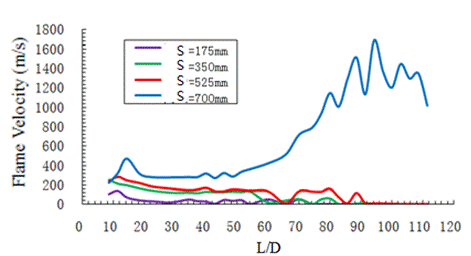Methane explosion is one of the most serious accidents in coal mine, which has become the major factor influencing coal mine safety production. We use a 40-meter long distance pipe with its inner diameter of 350mm to simulate flame propagation in coal mine, and investigate the influence of the methane concentration and obstacles on flame propagation law systematically.
1. Influence of concentration on flame velocity of methane explosion
We select five methane concentrations, which is 6%、8%、10%、12% and 14%, to study the influence of concentration on flame velocity without obstacles in the pipe. Figure 1 illustrates flame propagation process under different concentrations. From the curve, flame propagation shows a similar trend under the concentration of 8%、10% and 12%. When methane concentration is 10%, flame propagates fastest, and its velocity is 100m/s. Heat released by methane explosion is so much sufficient that it can overcome energy loss due to wall of pipe during its propagation process [1]. When methane concentration is close to the explosion limit, namely 6% and 14%, flame speed is so slow that its maximum velocity is only 20m/s, and flame easily quenched when propagating very short distance.
Fig.1 Flame speed versus L/D curves under different concentrations
2. Influence of obstacles on flame velocity of methane explosion
When methane explosion happens, the equipment in coal mine, such as coal winning machines, ventilators and harvesters, may increase fire disturbance and lead to very serious disasters by promoting flame acceleration, so the effect of number, spacing and block ratios of obstacles on flame propagation is investigated.
1) Number of obstacles
In experiment, 3, 6, 9 and 12 obstacles are selected to investigate the effect of obstacle number on flame speed of methane explosion under the condition of obstacles spacing of 350mm and block ratios of 0.3 and 0.6. Figure 2 and 3 show curves of flame speed under the condition of different obstacle number. L/D denotes the ratio of the length L to the diameter D of the duct. When obstacle block ratio is 0.3, flame speed increases with the increase of obstacle numbers. Flame is easily disturbed when more obstacles are put in the pipe and deflagration to detonation transition may occur under certain conditions[2]. When obstacle block ratio is 0.6, the overall flame speed shows increasing tendency with the increasing of obstacle numbers, but flame velocity is lower under 12 obstacles than that of 9 obstacles, which indicates 9 obstacles have totally realized the full potential of the flame acceleration. Flame speed oscillations are due to the interaction of flame and shock waves, and the collision of shock waves between obstacles. Besides, whether the flame is in the best acceleration situation also determines its later development tread after leaving obstacles [3].

Fig.2 Flame speed versus L/D under 8% concentration with different obstacle numbers
(Block ratio is 0.3)
Fig.3 Flame speed versus L/D under 8% concentration with different obstacle numbers
(Block ratio is 0.6)
2) Spacing of obstacles
Spacing of obstacles is a major factor that influence flame acceleration. We select obstacle spacing of 175mm, 350mm, 525mm and 700mm to investigate the effect of obstacles spacing on flame propagation of methane explosion. In all cases, concentration of methane is 8%, obstacle number is 6, and block ratios of obstacles are 0.3 and 0.6. Flame propagation curves in different obstacles spacing are shown in figure 4 and 5. The flame speed tend to increase with obstacle spacing. Deflagration to detonation transition may occur when spacing is large enough. Small obstacle spacing does not necessarily promote flame propagation. This can be explained by the following reasons: On the one hand, flame begins to interact with next obstacle before it doesn’t experience enough disturbance, and flame will lose a significant portion of energy interacting consecutive obstacles, which is not helpful for flame acceleration. On the other hand, in case of denser obstacles, flame acceleration distance and time become shorter, and flame separates with obstacles before it experiences adequate disturbance. This leads to failing to detonation.

Fig.4 Flame speed versus L/D under 8% concentration with different obstacle spacing
(Block ratio is 0.3)
Fig.5 Flame speed versus L/D under 8% concentration with different obstacle spacing
(Block ratio is 0.6)
3) Block ratio of obstacles
In experiment, concentration of methane is 8% and 10%, and obstacle number is 6. Obstacle block ratio of 0.3、0.45、0.6 and 0.75 is selected to investigate the influence on flame speed. Figure 6 and 7 reveal flame speed under different obstacle block ratios with different concentrations. When methane concentration is 8%, obstacles with larger block ratio is helpful for flame acceleration, and deflagration to detonation transition even occurs under certain conditions[4]. When methane concentration is 10%, detonation occurs when block ratios are 0.3 and 0.75, which indicates that methane concentration also plays the main factor of restricting flame acceleration under certain obstacle block ratio.
Fig.6 Flame speed versus L/D under 8% concentration with different obstacle block ratios
Fig.7 Flame speed versus L/D under 10% concentration with different obstacle block ratios
Acknowledgement
This research is supported by the Specialized Research Foundation for the Doctoral Program of Higher Education of China under grant 20121101110004, Beijing Natural Science Foundation (8132034), and the Foundation of State Key Laboratory of Explosion Science and Technology (Grant No. ZDKT11-01).
Reference:
[1] Hjertager B H, Fuhre K, Bjørkhaug M. Concentration effects on flame acceleration by obstacles in large-scale methane-air and propane-air vented explosions. Combustion science and technology, 1988, 62(4-6): 239-256.
[2] Teodorczyk A, Lee J H S, Knystautas R. The structure of fast turbulent flames in very rough, obstacle-filled channels. Symposium (International) on Combustion. Elsevier, 1991, 23(1): 735-741.
[3] Ciccarelli G, Johansen C T, Parravani M. The role of shock–flame interactions on flame acceleration in an obstacle laden channel. Combustion and Flame, 2010, 157(11): 2125-2136.
[4] Chan C K. Collision of a shock wave with obstacles in a combustible mixture. Combustion and Flame, 1995, 100(1): 341-348.

